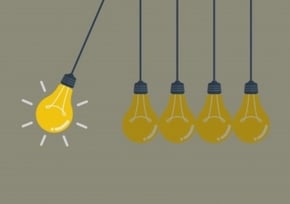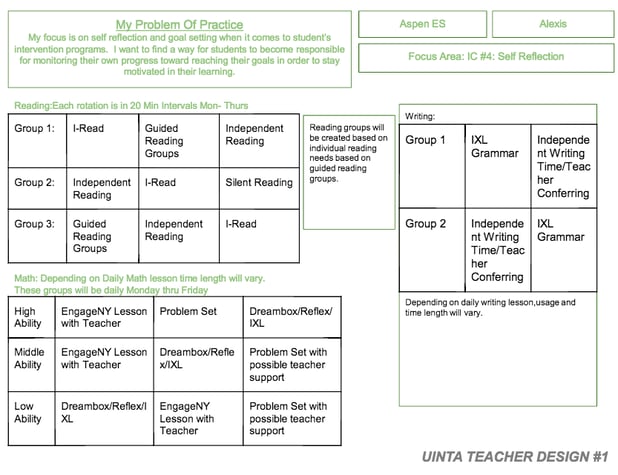
Often when we think about innovation we imagine a world where boldness and creativity rule-- free form design, hundreds of post it notes, wild experimentation, extreme risk-taking, rainbows! But I’ve found in my experience working with schools for the past 14 years that innovation is often best fostered by structured supports.
We need to build in choices, options, and ownership so that anyone in an organization can innovate,![]() but we also need to build in checks, goals, and vision so that we know why we’re innovating and how to confirm we’ve made our schools better. This idea of innovation within structure is the foundation behind bestsellers like The Lean Start Up and The Innovator’s Method. Try something small, test it, learn from your test, and then iterate, expand, or scrap your idea based on evidence and critical reflection.
but we also need to build in checks, goals, and vision so that we know why we’re innovating and how to confirm we’ve made our schools better. This idea of innovation within structure is the foundation behind bestsellers like The Lean Start Up and The Innovator’s Method. Try something small, test it, learn from your test, and then iterate, expand, or scrap your idea based on evidence and critical reflection.![]() The challenge is that we often don’t know how to measure the success or failure of something in a system as big as a school district.
The challenge is that we often don’t know how to measure the success or failure of something in a system as big as a school district.![]() It’s easy for me to know if my personal exercise program is working--I look fitter, I feel better, I run faster, etc. But when it comes to measuring the impact of changing one or two practices in a classroom, school, or district with hundreds of inputs, it can be difficult to pinpoint what exactly is working or not working.
It’s easy for me to know if my personal exercise program is working--I look fitter, I feel better, I run faster, etc. But when it comes to measuring the impact of changing one or two practices in a classroom, school, or district with hundreds of inputs, it can be difficult to pinpoint what exactly is working or not working.
That’s why I’m so thrilled about the Blended Learning Innovation Configuration that the Uinta County School District #1 team has developed.![]() Superintendent Dr. James Bailey, Chief Technology Officer Jaruan Dennis, and principals, teachers, and blended learning leads from across the district have helped to shape this document which helps to guide those essential reflections---What are we trying to do? Is what we’re doing working? Is what we’re doing better for students?
Superintendent Dr. James Bailey, Chief Technology Officer Jaruan Dennis, and principals, teachers, and blended learning leads from across the district have helped to shape this document which helps to guide those essential reflections---What are we trying to do? Is what we’re doing working? Is what we’re doing better for students?
Last month, my colleagues Scott Johns, Liz Kopp, and I had the chance to work with 64 UCSD #1 blended learning fellows (teachers who opted to transform their classroom to a blended model this year). During our two days together, teachers used the Innovation Configuration to help them narrow in on a problem of practice they think blended learning could help them solve.![]() From there, they created designs for their specific grade level and subject areas. They will launch these designs this week! Here are a few of these teacher-created designs, including their innovation configuration (IC) focus areas and problems of practice:
From there, they created designs for their specific grade level and subject areas. They will launch these designs this week! Here are a few of these teacher-created designs, including their innovation configuration (IC) focus areas and problems of practice:

I hope these designs and the Innovation Configuration will help you-- whether you’re a teacher, principal, or district leader-- to think about how you can build more structure into your innovation processes![]() so that you can inspire creativity and measure if what you’re creating is actually working. If you have questions or ideas about how to develop innovation at your site-- reach out to me via twitter @kearaduggan or the Ed Elements team.
so that you can inspire creativity and measure if what you’re creating is actually working. If you have questions or ideas about how to develop innovation at your site-- reach out to me via twitter @kearaduggan or the Ed Elements team.
Header image by Sira Anamwong, by freedigitalphotos.net




